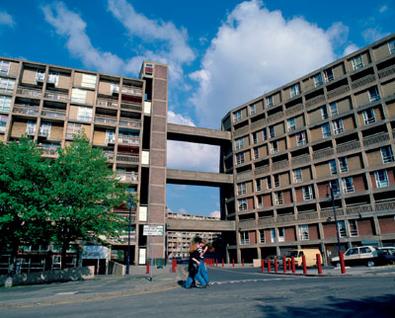



Being from Sheffield myself, it is interesting to see the comparisons made between Park Hill and Hulme Crescents. Both having been built on the basis of LeCorbusier's Unite d'Habitiation in Marseilles; one is now demolished and looked upon with distain, whereas the other is now Europe's largest listed building and is viewed as a building of architectural and sociological importance and is part of a major regeneration project by Urban Splash?
Whenever I went into Sheffield city centre I always looked up at the Park Hill Estate and counted my blessings that I didn't live there. It always looked like an incredibly dank, miserable, and unsafe block of flats. So it came as a great surprise to find out in 1998 that it was being awarded Grade II Listed Status and that it was to be the recipient of a £160 million renovation by Urban Splash. Like Hulme Crescents, Park Hill (designed by Ivor Smith and Jack Lynn) was seen as the future. The flats dominate the local skyline and earned the nick name of 'the streets in the sky' due to the fact that inter connecting walk ways stretch from each adjacent block. The streets where named, The Pavement, Gilbert Row, Hague Row, Long Henry Row and Norwich Row, and where that wide a Milk Float could actually drive down them via coming up the service lifts. Park Hill at the time was seen as the way forward, Construction is of an exposed concrete frame with yellow, orange and red brick curtain walling, which over the years has been stained by soot from passing trains. Sadly though, as with Hulme Crescents, although not to the same degree, the flats become overrun with drugs and crime and resident numbers diminished.
So, what made Park Hill the beacon of Modernist urban housing and Hulme Crescents a site worthy of demolition? Well the general consensus is that it was all down to the feeling of community. The residents of the terraced housing which preceded Park Hill were all relocated together to the new estate, bringing with them a sense of community. The residents of Hulme's Victorian slums, however, were sent to live in new housing schemes all over the Manchester area, from Wythenshaw, to Moss Side, and so the Crecents' residents were now strangers to one another and there was no sense of community whatsoever. This, in addition that Hulme was of a much poorer build quality to Park Hill. With this type of Brutalist mass housing design still only being theory to Britain at this point, the reality was that Manchester's rainy climate did not agree with the concrete structure on the Crescents'. The Unite d'Habitiation in Marseille's warm and dry climate has fared much better!

No comments:
Post a Comment